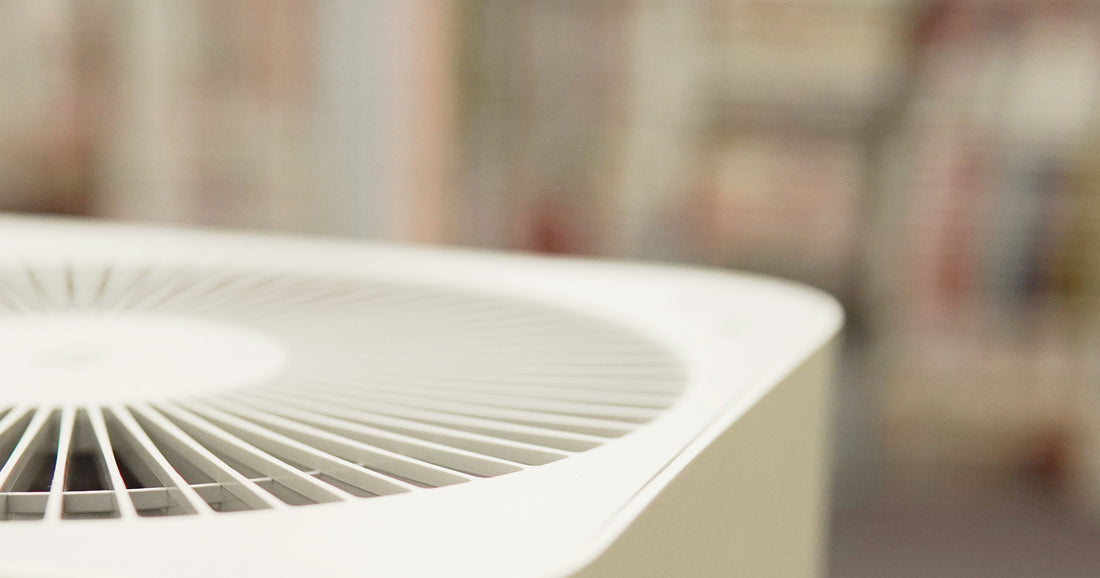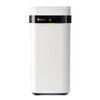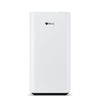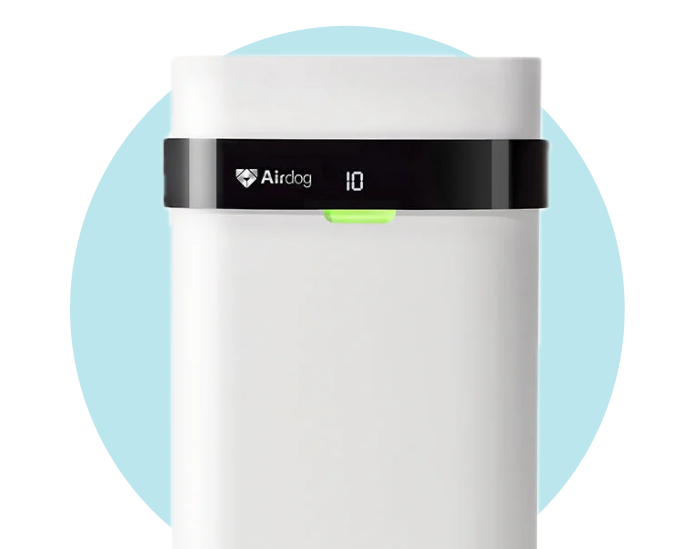Introduction: The Rise of DIY Air Purifiers
The Corsi-Rosenthal (CR) box gained attention in recent years as a homemade air purifier option made using box fans, MERV-13 filters, and duct tape. The Corsi-Rosenthal box originated from the need for an affordable but effective air purifier during the COVID-19 pandemic. Many have used this simple option to improve indoor air quality and reduce airborne virus particles quickly. In this blog we'll compare the performance, cost, and reliability of the Corsi-Rosenthal box to commercial air purifiers and to Airdog's own TPA technology to help you select the right option for cleaner indoor air and virus control.
What Is a Corsi-Rosenthal Box?
Jim Rosenthal and Richard Corsi are environmental engineers who developed the Corsi-Rosenthal box during the COVID-19 pandemic. Corsi-Rosenthal boxes consist of a box fan, several HVAC filters, and the important sealing material: duct tape.
Schools, homes, and community spaces have adopted Corsi-osenthal boxes as a DIY method to create a cleaner air environment. The design relies on science-based airflow and filtration to target fine particles such as dust, viruses, and smoke.
How Does a Corsi-Rosenthal Box Work?
The Corsi-Rosenthal box functions by drawing air through multiple MERV-13 filters arranged as the sides of a cube, using a box fan to pull air through and push out cleaner air. The filters capture fine particulate matter such as dust, pollen, smoke, and airborne viruses, improving indoor air quality. Sealing all the edges with duct tape ensures that air flows only through the filters, maximizing filtration efficiency. This simple design offers an affordable way to reduce airborne contaminants in various indoor environments.
Building a Corsi-Rosenthal Box: Materials & Assembly
Materials
To build the box you'll need:
-
A standard box fan
-
Four MERV-13 air filters
-
At least one roll of duct tape
-
Cardboard
-
Scissors or a box knife to cut the cardboard and tape
If you bought a new box fan, keep the cardboard box! You'll be able to use it as the base for your homemade air filter. The filters will be used to form four sides of a cube on the base, and the box fan will sit on top. Choosing filters that allow strong airflow matters. Most people build a CR box for $50 to $100, making it an affordable option.
Choosing Air Filters for Your Corsi-Rosenthal Box
Selecting the right air filters plays a critical role in how well your Corsi-Rosenthal box performs. Most builders use MERV-13 filters because they strike a balance between airflow and particle capture. These filters can trap common indoor pollutants like dust, pollen, mold spores, and airborne viruses around 1 micron in size. Higher-rated filters like MERV-14 or MERV-16 may capture smaller particles but can restrict airflow, which reduces efficiency and puts extra strain on the fan. Filters should match the dimensions of your box fan, typically 20"x20", to ensure a tight seal. Using filters with sturdy frames helps maintain structural stability during assembly. To ensure consistent air quality, plan to replace the filters every few months, especially in high-use environments like classrooms or shared living spaces.
Assembly
-
Gather all necessary materials: a standard 20"x20" box fan, four MERV-13 air filters of matching size, duct tape, cardboard (preferably from the box fan packaging), scissors or a box cutter.
-
Inspect the air filters and identify the airflow direction arrows printed on their frames. Ensure all filters are oriented so that these arrows point inward, indicating the direction air will flow through the filters into the box.
-
Arrange the four air filters upright on a flat surface to form four sides of a cube, with the airflow arrows pointing towards the inside of the cube. The filters should be placed edge to edge, forming a square or rectangular frame with one side left open on top.
-
Use duct tape to securely connect the edges of the filters together. Seal all the seams thoroughly to prevent any air leaks. Press firmly while taping to ensure a tight bond and airtight seal along all the edges.
-
Cut a piece of cardboard to fit the bottom of the cube formed by the filters, creating a sturdy floor. Attach the cardboard to the bottom edges of the filters using duct tape, sealing all the edges to maintain structural integrity and prevent air from bypassing the filters.
-
Place the box fan on the open side of the cube with the fan blowing outward (away from the filters). Confirm that the fan is centered and fully covers the opening.
-
Use duct tape to firmly attach the box fan to the filter cube, sealing all the edges between the fan frame and the filter edges. Make sure there are no gaps where unfiltered air could enter or escape.
-
Optionally, create a fan shroud by cutting cardboard to cover the corners of the box fan’s outlet side. Attach this shroud securely with duct tape to improve airflow efficiency by reducing backflow around the fan corners.
-
Inspect the entire assembly for any gaps or loose tape, especially around all the edges and corners. Add additional duct tape as needed to ensure the system is completely sealed.
-
Place your completed Corsi-Rosenthal box in the desired room, plug in the fan, and turn it on to start filtering indoor air. Regularly check and replace the filters every few months or as needed based on usage and air quality to maintain optimal performance.
Maintenance
Optimizing air flow is crucial for effective operation. The fan pulls air through the filters, capturing particles like pollen and dust. The positioning and sealing around the fan blades can significantly impact air flow and filtering efficiency, as gaps may reduce performance. Customizations, like fan shrouds, help enhance flow, and covering or modifying the fan outlet can further improve flow and reduce noise. Clean Air Delivery Rate (CADR) tests measure output. Periodic filter replacement keeps performance high.
Some people place CR boxes in bedrooms to support better sleep quality by reducing airborne particles. The CR box can supplement other air-quality strategies. Still, it falls short in particle capture, maintenance, and noise when compared to engineered air purifying systems like Airdog.
Airdog’s TPA Technology: A Superior Air Filtration Solution
CR boxes use disposable MERV-13 filters, and most commercial purifiers rely on HEPA filters that require regular replacement. That’s where Airdog’s Two-Pole Active (TPA) filtration system really shines. With Airdog, you don’t have to replace expensive filters to ensure top-quality filtration regularly. This system uses an electrostatic field to destroy and capture ultrafine particles without disposable filters.
How Airdog's TPA technology works
Airdog’s Two-Pole Active (TPA) technology uses an advanced electrostatic field to capture and destroy ultrafine particles that traditional filters often miss. Unlike conventional air purifiers that rely on disposable filters, Airdog’s system charges airborne particles, attracting them to washable collection plates where they are neutralized. This process effectively removes viruses, bacteria, smoke, pollen, pet hair, and even heavy metals from the air. The TPA technology ensures continuous high-efficiency filtration without the need to replace filters frequently, reducing both cost and environmental waste.
Airdog's Key Advantages Over the CR Box and Commercial Air Purifiers
Captures Smaller Particles
CR boxes remove particles as small as 1 micron. HEPA filters capture particles down to 0.3 microns. Airdog’s TPA technology removes particles as small as 0.0146 microns, including viruses, heavy metals, and smog.
No Ongoing Filter Costs
The CR box and most commercial purifiers need new filters every few months. Airdog units use washable plates, cutting costs and reducing waste.
Quieter Operation
Box fans in DIY purifiers tend to make more noise. Airdog purifiers operate quietly and suit bedrooms, offices, and other quiet spaces.
No Air Leaks
CR boxes may leave small air gaps during assembly. Some commercial units leak slightly depending on design. Airdog purifiers feature sealed systems that deliver full filtration.
Lab-Tested and Certified
Airdog purifiers destroy 99.9% of viruses and bacteria, outperforming the CR box and traditional commercial air cleaners.
By combining high-performance filtration, quiet operation, and low maintenance, Airdog offers a strong alternative to both DIY boxes and conventional air purifiers.
Corsi-Rosenthal Box vs. Airdog TPA Air Purifiers Comparison Chart
|
Feature |
Corsi-Rosenthal Box |
Airdog TPA Purifiers |
|
Filtration Efficiency |
MERV-13 (1+ microns) |
0.0146 microns |
|
Filter Replacement |
Every 3–6 months |
Washable plates |
|
Noise Level |
Loud (box fan) |
Quiet operation |
|
Airflow Leaks |
Possible tape gaps |
Fully sealed system |
|
Virus and Bacteria Removal |
Limited |
Destroys 99.9% |
|
Long-Term Cost |
$50–$150/year |
One-time purchase |
Airdog Outperforms the DIY Approach and Other Air Purifiers
The Corsi-Rosenthal box works as a short-term, low-budget solution for basic air filtration. Airdog’s TPA technology improves efficiency and eliminates virus particles at a microscopic scale.
People who value health, convenience, and long-term sustainability benefit most from Airdog’s advanced design. This system provides better results without needing costly filter replacements.
Ready to experience cleaner, healthier air? Explore Airdog’s full range of air purifiers and discover how easy it feels to breathe fresh air with confidence and consistency.
Shop Airdog Air Purifiers Now.





